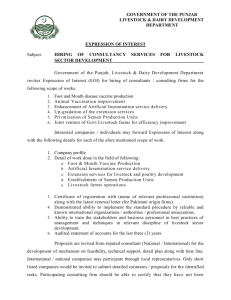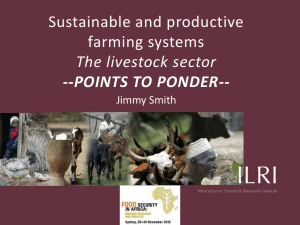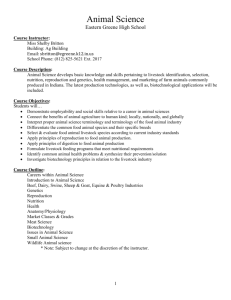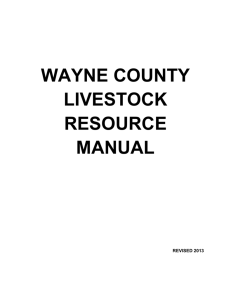Complete final report - Needs assessment livestock processing project
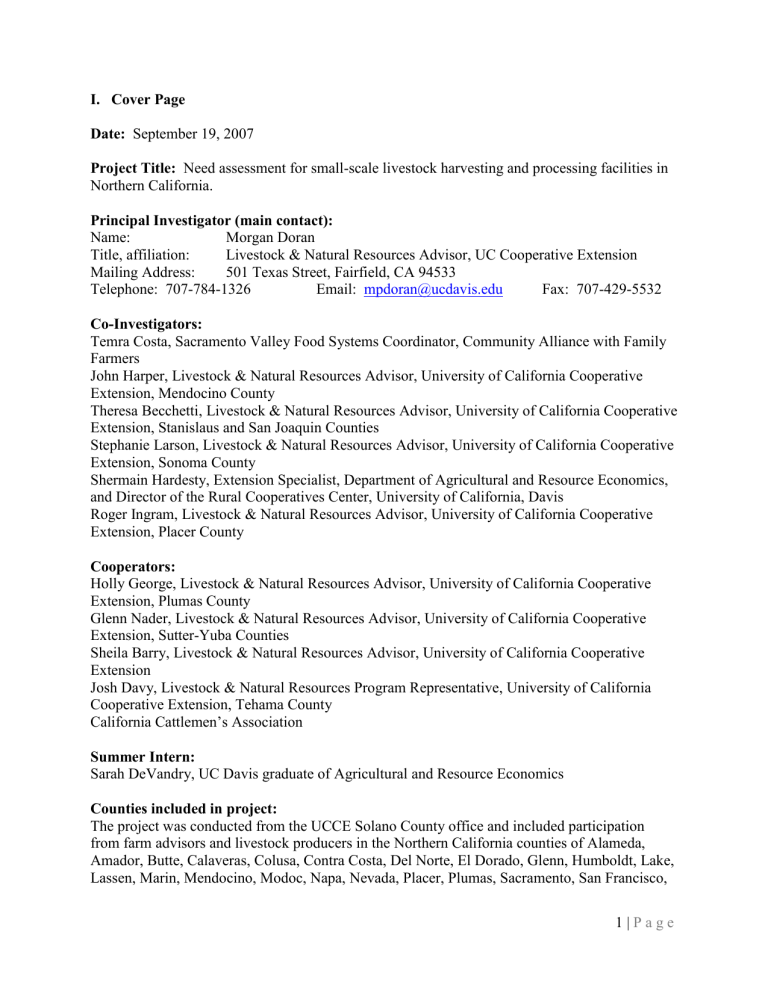
I. Cover Page
Date: September 19, 2007
Project Title: Need assessment for small-scale livestock harvesting and processing facilities in
Northern California.
Principal Investigator (main contact):
Name: Morgan Doran
Title, affiliation: Livestock & Natural Resources Advisor, UC Cooperative Extension
Mailing Address: 501 Texas Street, Fairfield, CA 94533
Telephone: 707-784-1326 Email: mpdoran@ucdavis.edu
Fax: 707-429-5532
Co-Investigators:
Temra Costa, Sacramento Valley Food Systems Coordinator, Community Alliance with Family
Farmers
John Harper, Livestock & Natural Resources Advisor, University of California Cooperative
Extension, Mendocino County
Theresa Becchetti, Livestock & Natural Resources Advisor, University of California Cooperative
Extension, Stanislaus and San Joaquin Counties
Stephanie Larson, Livestock & Natural Resources Advisor, University of California Cooperative
Extension, Sonoma County
Shermain Hardesty, Extension Specialist, Department of Agricultural and Resource Economics, and Director of the Rural Cooperatives Center, University of California, Davis
Roger Ingram, Livestock & Natural Resources Advisor, University of California Cooperative
Extension, Placer County
Cooperators:
Holly George, Livestock & Natural Resources Advisor, University of California Cooperative
Extension, Plumas County
Glenn Nader, Livestock & Natural Resources Advisor, University of California Cooperative
Extension, Sutter-Yuba Counties
Sheila Barry, Livestock & Natural Resources Advisor, University of California Cooperative
Extension
Josh Davy, Livestock & Natural Resources Program Representative, University of California
Cooperative Extension, Tehama County
California Cattlemen’s Association
Summer Intern:
Sarah DeVandry, UC Davis graduate of Agricultural and Resource Economics
Counties included in project:
The project was conducted from the UCCE Solano County office and included participation from farm advisors and livestock producers in the Northern California counties of Alameda,
Amador, Butte, Calaveras, Colusa, Contra Costa, Del Norte, El Dorado, Glenn, Humboldt, Lake,
Lassen, Marin, Mendocino, Modoc, Napa, Nevada, Placer, Plumas, Sacramento, San Francisco,
1 | P a g e
San Joaquin, San Mateo, Santa Clara, Shasta, Sierra, Siskiyou, Solano, Sonoma, Stanislaus,
Sutter, Tehama, Trinity, Tuolumne, Yolo and Yuba.
Budget:
A. Personnel
Student Assistant III, 100% for three months
UC SAREP
$ 6,864
Matching
0
Employee benefits
B. Supplies and Expenses
Postage for 3000 surveys @ $ 0.39 each
Paper and envelopes for surveys
Consultation with Survey Research Center, UC
Berkeley
Conference calls, 8 people for 120 minutes @
$0.09/min.
Misc. office supplies
$ 1,200
$ 1,170
$ 250
$ 125
$ 87
0
0
0
0
0
C. Travel
10 trips between Fairfield and Davis @ $ 23.00 each
TOTALS
$ 50
$ 230
$ 9,976
0
0
0
2 | P a g e
II. Goals and Objectives
The goal of this project is to quantify the need for small-scale livestock harvesting and processing facilities in Northern California and to extend this information to targeted audiences.
The objectives for the project are to quantify various factors that describe the current and desired supply of and demand for harvesting and processing services, and determine optimal geographic locations for new facilities.
Specific objectives:
1.
Survey approximately 300 Northern California ranchers to determine: a.
their current niche marketing efforts and success. b.
their interest in entering and expanding niche market sales. c.
the species and number of livestock they would like to process. d.
the time of year they would seek processing services. e.
the type of processing they need (USDA and non-USDA inspection). f.
the type of product they produce (organic, grass-fed, natural, etc.). g.
which special value-added products they would offer. h.
the types and locations of their target markets. i.
their geographical preferences for processing facilities.
2.
Survey current livestock harvesting and processing facilities in Northern California to determine the current processing capacity.
3.
Extend project conclusions to target audiences through publications, newsletters, workshops and conferences.
III. Summary
This project seeks to quantify the need for small-scale livestock harvesting (slaughtering) and processing (butchering) services in Northern California and determine ideal geographic areas for such businesses. In Northern California many livestock producers are looking toward niche markets as more profitable outlets for meat products. A problem that prevents or slows entry into niche markets is the lack of USDA- and State-inspected harvesting and processing facilities.
Groups of producers have expressed considerable interest in constructing new facilities in
Northern California. In order to determine the demand for harvesting and processing services we surveyed livestock producers throughout Northern California to quantify their interest in new livestock harvesting and processing facilities, the type and number of animals they would like to process, and preferred geographical locations for such facilities.
In August of 2006, we sent a four-page survey to livestock producers throughout Northern
California using addresses provided by UCCE Livestock Advisors. A total of 5,312 surveys were sent with 497 completed surveys returned, equaling a 9.4% return rate. Data entry of all returned surveys was completed in mid-summer 2007. As of August 2007, we are conducting data quality control checks in preparation for statistical analysis. Although the statistical analysis is not complete, a partial view of the data demonstrates the need for small-scale livestock processing facilities.
3 | P a g e
Preliminary survey results show that respondents are generally satisfied with the quality and timeliness of service they currently receive from existing processing facilities, but over 70% indicate that the current availability and accessibility is either very deficient (52%) or slightly below (20%) the current demand of such services. Respondents (56%) who indicated interest in using small-scale processing facilities identified access to slaughter and processing services as the largest barriers that limit entry into alternative niche markets. They also indicated that they would be most interested in selling their meat products in the following markets in descending order: local counties, adjacent counties, the Bay Area, the Sacramento region, internet sales, and
Southern California.
The survey results indicate that Northern California livestock producers have a desire to market meat products in local and regional niche markets, but are limited by access to slaughtering and processing facilities. If new facilities are built to meet the current demand, strategic locations should be sought to minimize the travel distance from livestock production centers to slaughtering and processing facilities and then to suitable markets for meat products. Most survey respondents are unwilling to travel beyond 90 minutes when delivering live animals to slaughter facilities. Almost 90% of respondents are willing to travel 60 minutes, but 55% are willing to travel 90 minutes and only 28% will travel up to 120 minutes.
A more comprehensive data analysis that will be completed by late-2007 will provide details on demand for slaughtering and processing services at a county scale, which will be useful in determining strategic locations for new facilities in Northern California.
IV. Project Results and Outcome
Livestock producers typically sell their animals through traditional markets such as auction yards and brokers. These market segments usually broker the sale of young animals from livestock producers to other producers for further grazing or to feed lots for finishing (fattening) on highgrain diets prior to slaughter. Fattened animals are then sold to meat packing companies that harvest the animals and package meat cuts for final distribution to meat wholesalers and retailers.
Consolidation of meat packers in the United States has improved efficiency in the meat processing industry, but has not necessarily benefited livestock producers (Azzam and Schroeter
1997), and is often blamed for the closing of small-scale meat processing facilities. Large meat packing companies will continue to have an important role in providing lower-cost products to consumers in the foreseeable future, but they have difficulty supplying meat to consumers demanding locally raised, organic, natural, grass-fed and humanely treated products.
This project was structured to accomplish the stated goal of quantifying the need for small-scale livestock slaughtering and processing (slaughter and processing will be referred to collectively as processing in the remainder of this report) facilities in Northern California and to extend this information to targeted audiences. To accomplish this goal we surveyed 497 livestock producers, which represent 9.4% of the 5,312 surveys that were sent in August 2006. The final number of 497 completed surveys is almost 200 more than the initial objective of surveying 300 producers. The number and percentage of returned surveys by county is shown in Figure 1.
Farm size profiles (Figure 2) for the respondents were generally consistent with California data
4 | P a g e
from the Census of Agriculture (USDA, 2002) with respect to farm size and the ratio of beef to sheep producers. Producers with fewer than 50 animals comprised the greatest number of respondents in all animal class categories.
Survey questions were formulated to solicit information from respondents on current niche marketing efforts, satisfaction with current processing infrastructure and services, preferences for services and location of processing facilities, and how much they would utilize processing facilities if they were available. Questions and survey form format were developed through the collaboration of all the team members via email and conference calls.
Livestock producer addresses were obtained from newsletter mailing lists maintained by UCCE livestock advisors throughout Northern California. Addresses that were obviously not of a livestock producer were removed from the mailing list, resulting in a final list of 5,967 addresses that received a survey. A total of 655 surveys were returned either by the Postal Service and marked as “Not Deliverable” or by people who stated that they do not have livestock and are not interested in the survey. The 655 returned surveys was subtracted from the total number sent
(5,967) to establish the final number of 5,312 surveys that are assumed to have been sent to legitimate livestock producers.
Although a submission deadline was set for September 8, 2006, completed surveys continued to arrive through January 2007. A standard numeric score was set for each survey answer and all answers on each completed survey were translated to a numeric score sheet for a more efficient data entry process.
Preliminary survey results indicate that livestock producers are generally satisfied with the existing processing facilities, but the number of facilities is insufficient to meet the current demand for such services. When asked to rate their satisfaction with current services on a scale of 1 to 5 (1=not satisfied, 5=very satisfied), the average response was 3.6 for both quality (Figure
3) and timeliness (Figure 4). Despite their high satisfaction with current services, 72% of respondents indicated that the current facilities are not meeting the current demand, with 52% saying the availability and accessibility is very deficient (Figure 5). Further questions indicated that access to processing services is the largest barrier that limits entry into alternative niche markets for selling meat products.
As niche marketing opportunities increase for meat products, livestock producers will base their decision on where and how to sell their animals on many factors, some of which include price, marketing costs, access to processing, and market familiarity. Even though niche markets may offer higher prices than traditional markets, some producers will stay with traditional markets because they are satisfied with the price, familiar with the market, and see too much risk in niche markets for their operation. Other producers will venture into niche markets to sell all their animals or by dedicating a fraction of their crop to niche markets and the rest to traditional markets. This latter group of producers most likely characterizes the 56% of respondents who indicated an interest in using small-scale processing facilities. The proportion of producers willing to enter niche markets may increase if availability and access to processing services increase and if additional marketing channels are opened and become more familiar to producers.
5 | P a g e
Respondents who identified themselves as being interested in using small-scale processing facilities were asked to answer several questions on their criteria for using such facilities and how many animals they would like to have processed. Some of the results from these questions are summarized in Figures 6, 7 and 8, and Table 1. Travel time from the producer’s location to the processing facility and then to the final market and the producer’s willingness to travel that distance is an important factor for the producer in deciding to enter niche markets. Producers identified strong preferences to sell meat products in their local and adjacent counties, followed by the Bay Area and the Sacramento region (Figure 6). Internet sales and sales to Southern
California ranked the lowest. This information on targeted markets combined with the maximum distance producers are willing to travel, one-way, to processing facilities will be useful in determining ideal locations for establishing processing facilities. Figure 7 quantifies the willingness of producers to travel the one-way distance to have their livestock processed and the proportion of producers captured at each maximum distance. A critical point appears to occur at maximum travel times of 60 and 90 minutes. Approximately 90% of respondents are willing to travel 60 minutes, but that percentage drops to 55% at a maximum travel time of 90 minutes and only 28% are willing to travel 120 minutes. These results suggest that new processing facilities must be located at distances between 60 and 90 minutes from core areas of livestock production.
An ideal location will also minimize the distance from the processing facility to important markets for its producer clients. Our project team will pursue a more in-depth analysis of the survey data to determine preferable locations for future small-scale processing facilities, on a county or multi-county basis.
Proper market characterization is another important factor that is necessary to consider when planning the establishment of future processing facilities. In the case of small-scale processing facilities, the market is comprised of livestock producers and perhaps meat wholesalers who purchase locally-raised animals that fit their niche markets. A market characterization should reveal the potential class and number of animals that will be available by producers for processing on a seasonal and annual basis. Table 1 shows the number of steers/heifers, lambs, goats and hogs respondents indicated that they would like to market each month, assuming that processing facilities were readily available and accessible. The data in Table 1 is graphically represented in Figure 8, which shows a spike in the number of steers and heifers in May and June followed by a more modest increase in November and December. These peaks correspond to a
14 month period of time following spring and fall calving schedules, which is approximately the amount of time required to raise a beef steer or heifer to a marketable weight. A processing facility manager may have difficulty in accommodating such dramatic fluctuations with a static number of employees throughout the year, which may be a good incentive for producers to try extending the period of time when they finish and market their animals.
V. Evaluation/Lessons Learned
Throughout the execution of the project, our team has continuously evaluated the project’s success in efficiently attaining a 10% return rate and in obtaining good quality data. Evaluation started by testing the survey on a small number of livestock producers throughout the state and incorporating their feedback on the final survey. Consultations were also conducted with a programmer in the Department of Agricultural and Resource Economics at UC Davis, who has expertise in conducting surveys, to ensure that the survey is structured correctly for statistical
6 | P a g e
analysis. The importance of this step cannot be overstated, as there were many pivotal corrections and changes in our process that resulted from this consultation. Another adjustment was made as a result of a suggestion from UC SAREP that we expand our initial scope to include all Northern California counties. We were able to expand the project through saving in salary and benefits paid to our intern. Much of the success in sorting and organizing addressees, sending the surveys, cataloging completed and returned surveys and scoring the completed surveys is due to the tremendous effort made by Sarah DeVandry, who spent the summer of
2006 interning with Cooperative Extension to work on this project. The time she spent organizing databases at the front end of the project has been a valuable investment throughout the remainder of the project.
Although many respondents were able to correctly complete all survey questions, we did notice that many had difficulties responding to several of the more complex questions, and some answered simple questions incorrectly. We have learned that despite precise instructions, it is best to ask respondents to rate rather than rank choices to a question. When asked to rank, many respondents would answer by rating the choices with a number or a checkmark. We did have very good responses to rating questions in which we asked respondents to fill in a box indicating their answer.
One project outcome that will extend the impact of this project is the successful funding of an economic development grant obtained by several investigators on this project. The new grant will fund a project to determine the feasibility of a ~20,000 head/year processing facility in
Mendocino or northern Sonoma County. The project will include livestock producer meetings in all counties within a two-hour driving distance of southern Mendocino County to determine more precise information on animal supply and economic considerations. More interviews will be conducted to readdress some of the issues that respondents had difficulty answering on our survey.
VI. Outreach/Education/Dissemination of Findings
Preliminary findings from the survey have been presented at various producer meetings including the annual Niche Meat Marketing Conference held in March 2007 with about 60 participants and at county Cattlemen’s Association meetings. Data summaries have also been provided to people in various counties working on economic development projects with a particular interest in establishing processing facilities that will serve their local agriculture industry. Upon completion of the data analysis, our project team intends to publish the survey results in California Agriculture and in UCCE Livestock Advisor newsletters. These articles will be linked from UCCE county web-sites. We will also continue presenting project findings at appropriate meetings and conferences throughout Northern California.
VII. Literature Cited
Azzam, A. and J.R. Schroeter. 1997. Concentration in beef packing: Do gains outweigh losses?
Choices (1 st
quarter): 26-28.
7 | P a g e
US Department of Agriculture. ONLINE. 2002. Census of Agriculture-State Data, California.
USDA. Available: http://www.nass.usda.gov/census/census02/volume1/ca/index1.htm
8 | P a g e
Figure 1. Number and percentage of returned surveys by county.
25
20
15
10
5
0
50
45
40
35
30
Surveys Returned % Return
25
20
15
10
5
0
9 | P a g e
Figure 2. Farm size of respondents based on number of animals.
180
160
140
120
100
80
60
40
20
0
<50 50-99 100-199 200-499
Size class for number of livestock
>500
Cow-calf Weaned Calves Sheep Goats
Figure 3. Satisfaction rating on quality of service from existing processing facilities.
70
60
50
40
30
20
10
0
1 2 3 4 5
Not Satisfied Very Satisfied
10 | P a g e
Figure 4. Satisfaction rating on timeliness of service from existing processing facilities.
70
60
50
40
30
20
10
0
1 2 3 4 5
Not Satisfied Very Satisfied
Figure 5. Current availability and accessibility of processing facilities.
250
200
150
100
50
0
Very deficient Slightly below demand
Just enough Very available and accessible
11 | P a g e
Figure 6. Ranking of target markets (1=lowest priority, 5=highest priority).
5
4,5
4
3,5
3
2,5
2
1,5
1
0,5
0
Figure 7. Maximum time respondents are willing to travel for processing services. Percentages represent the proportion of producers captured at each time increment.
120
89%
100
55%
80
60
40
20
0
100%
98%
28%
12%
4%
0-15 16-30 31-60 61-90 91-120 121-180 >180
Travel time (minutes)
12 | P a g e
Table 1. Total number of animals that respondents would like to have processed in small-scale facilities each month of the year.
Class of Animal Jan Feb Mar Apr May Jun Jul
Steers/heifers 392 264 767 843 2,290 1,806
Aug Sep
1,239 925 1,170
Oct
1,507
Nov Dec
1,863 1,779
Total
14,845
Lambs
Goats
Hogs
156 136
1
150
1
150
354
1
338 365
120 166
153 150
753
265
176 153
594
89
832
78
152 174
900
80
658
145
150 154
1,084
225
1,462
50
220 203
7,632
1,221
1,985
Figure 8. Graphical representation of Table 1 showing the total number of animals respondents would like to have processed in smallscale facilities.
2 500
2 000
1 500
1 000
500
Steers/heifers
Lambs
Goats
Hogs
-
13 | P a g e

